Rosa Mariana Soup (Italian Orzo Soup with Chicken and Tomato)
Comforting yet vibrant, Rosa Mariana Soup is a soul-warming Italian classic that blends the heartiness of tender orzo with the brightness of herbs, lemon, and tomato.
Infused with layers of aromatic rosemary, thyme, and garlic, and finished with a touch of cream and lemon juice, this soup delivers depth without heaviness.
Whether enriched with shredded chicken or kept light and vegetarian, each bowl offers a harmonious balance of savory broth, silky pasta, and fresh greens—perfect for cozy evenings, healing days, or simply nourishing yourself with something wholesome and elegant.
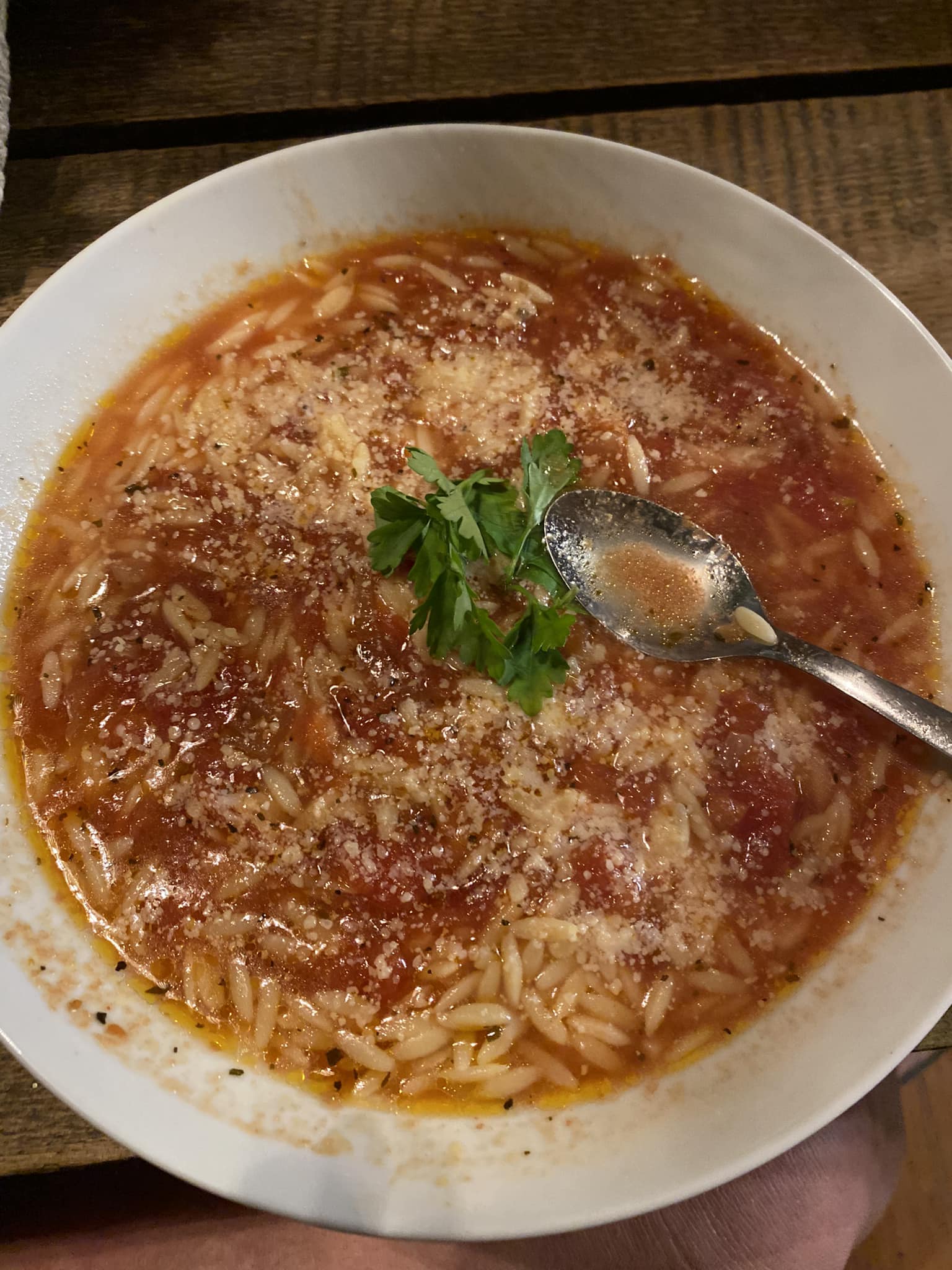
Why People Will Love Rosa Mariana Soup:
Balanced Comfort and Freshness:
It delivers the coziness of a creamy, tomato-based soup with the lightness of lemon, herbs, and spinach—ideal for those who want something comforting yet not overly heavy.
Layered, Aromatic Flavor:
Fragrant herbs like rosemary and thyme, combined with sautéed garlic and onion, create a rich, savory depth that feels both rustic and refined.
Customizable for Every Diet:
With optional ingredients like cream, spinach, and shredded chicken, this recipe can easily adapt to vegetarian, dairy-free, or high-protein preferences—making it widely appealing.
Texture-Perfect Experience:
The use of orzo (or Rosa Marina pasta) offers a silky, tender texture that absorbs flavor beautifully and brings a satisfying mouthfeel without overpowering the broth.
Elegant Yet Easy to Prepare:
Though it feels elevated and restaurant-worthy, the recipe uses accessible ingredients and simple steps, making it achievable even for beginner cooks.
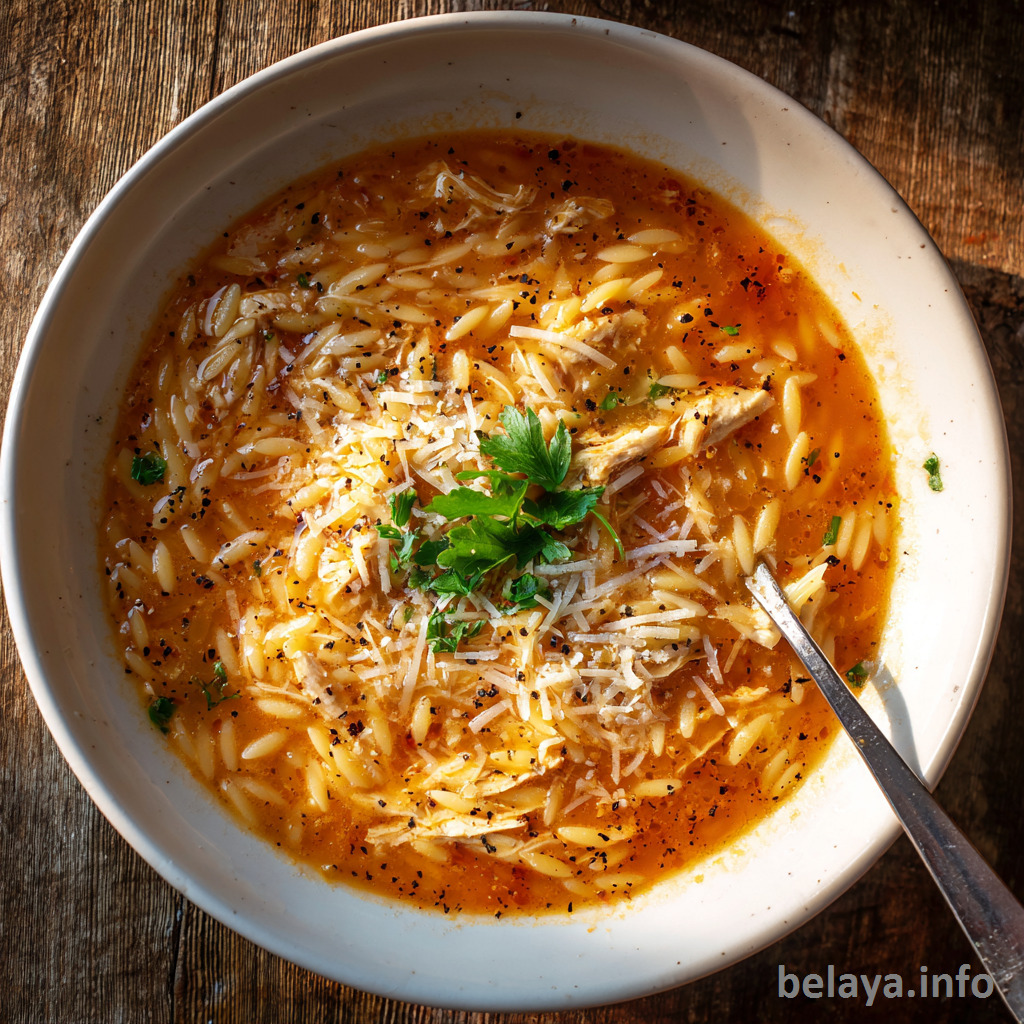
Key Ingredients:
Onion and Garlic:
These aromatics form the foundational layer of the soup, releasing natural sweetness and depth as they’re sautéed—crucial for building a savory base that carries the flavors of herbs and tomato.
Butter:
The butter not only enhances the richness of the sautéed aromatics but also adds a velvety texture to the broth, making the soup feel indulgent yet balanced.
Herbs (Thyme and Rosemary):
Infusing the soup with fresh, earthy notes, these herbs lend a rustic Italian charm while elevating the overall complexity and aroma of the dish.
Chicken or Vegetable Stock:
Serving as the broth’s backbone, the stock adds savory depth and warmth. Using low-sodium stock ensures that the natural flavors of the ingredients shine without overwhelming saltiness.
Orzo (Rosa Marina Pasta):
This tender, rice-shaped pasta absorbs the broth’s flavors perfectly while offering a pleasing, light texture that balances the soup’s creaminess and heartiness.
Tomato Paste/Purée:
Concentrated tomato flavor brings a rich, tangy intensity to the soup, harmonizing with the savory herbs and stock for a multidimensional taste profile.
Balsamic Vinegar and Worcestershire Sauce (Optional):
These ingredients introduce subtle acidity and umami, enhancing the overall complexity and brightening the soup’s flavor layers without overshadowing the natural ingredients.
Heavy Cream (Optional):
When added, the cream provides a luxurious, smooth texture that enriches the soup, creating a velvety finish that contrasts beautifully with the slight acidity of the tomatoes and lemon.
Spinach (Optional) and Shredded Chicken (Optional):
The spinach adds a burst of freshness and vital nutrients, while the shredded chicken contributes lean protein and a comforting heartiness that makes the soup versatile and satisfying.
Lemon Juice:
A squeeze of fresh lemon at the end brings brightness and a balancing acidity that ties all the flavors together, lifting the dish and adding a touch of elegance.
Parmesan Shavings and Fresh Basil or Parsley:
These garnishes not only add a final burst of flavor and an aromatic finish but also elevate the presentation, making each serving feel both rustic and refined.

Expert Tips:
Use Low-Sodium Stock for Full Flavor Control
Opt for low-sodium chicken or vegetable stock so you can season in layers without oversalting. This allows the herbs, tomato paste, and optional umami enhancers to shine without interference.
Toast the Tomato Paste
When adding the tomato paste to the pot, let it cook for 1–2 minutes before adding the stock. This caramelizes the natural sugars and removes any raw, tinny taste—deepening the body of the soup.
Cook Orzo Separately to Avoid Mushiness
Orzo can easily overcook and turn starchy if boiled directly in the soup. Cooking it separately and adding it just before serving keeps the texture al dente and distinct, especially if you plan to store leftovers.
Bloom the Herbs in Fat
Sautéing the rosemary and thyme with butter (or olive oil) early in the cooking process releases their essential oils, intensifying their aroma and weaving them seamlessly into the flavor of the broth.
Use Rotisserie Chicken for Convenience
If you’re short on time, shredded rotisserie chicken is a flavorful and easy substitute that integrates beautifully without sacrificing depth.
Balance Creaminess with Acid
If using cream, always finish the soup with lemon juice after removing from heat. This preserves its brightness while preventing curdling. Acid also cuts through richness and balances the mouthfeel.
Garnish Generously
A few shavings of Parmesan and a sprinkle of fresh herbs add not only flavor but texture and contrast. For an elevated finish, try a drizzle of herb oil or a few drops of good balsamic vinegar before serving.
Double the Batch for Next-Day Magic
This soup tastes even better the next day. Make extra and store components separately (especially orzo) to preserve texture and freshness when reheating.

How to make Rosa Mariana Soup (Italian Orzo Soup with Chicken and Tomato)
Ingredients:
1 onion finely chopped
4 cloves garlic crushed
30 g (2 tbsp) butter
2 tsp thyme leaves
2 tsp rosemary finely chopped
1 litre chicken or veg stock
200 g (7 oz) Rosa Marina pasta or orzo
60 g (½ cup) tomato paste/puree
1 tbsp balsamic vinegar (optional)
2 tsp Worcester sauce (optional)
60 ml (4 tbsp) heavy cream (optional)
salt to taste
1 tsp pepper
100 g (3 cups) spinach (optional)
200 g (7 oz) cooked shredded chicken (optional)
1 lemon juice
To serve
Parmesan shavings
fresh basill or parlsey
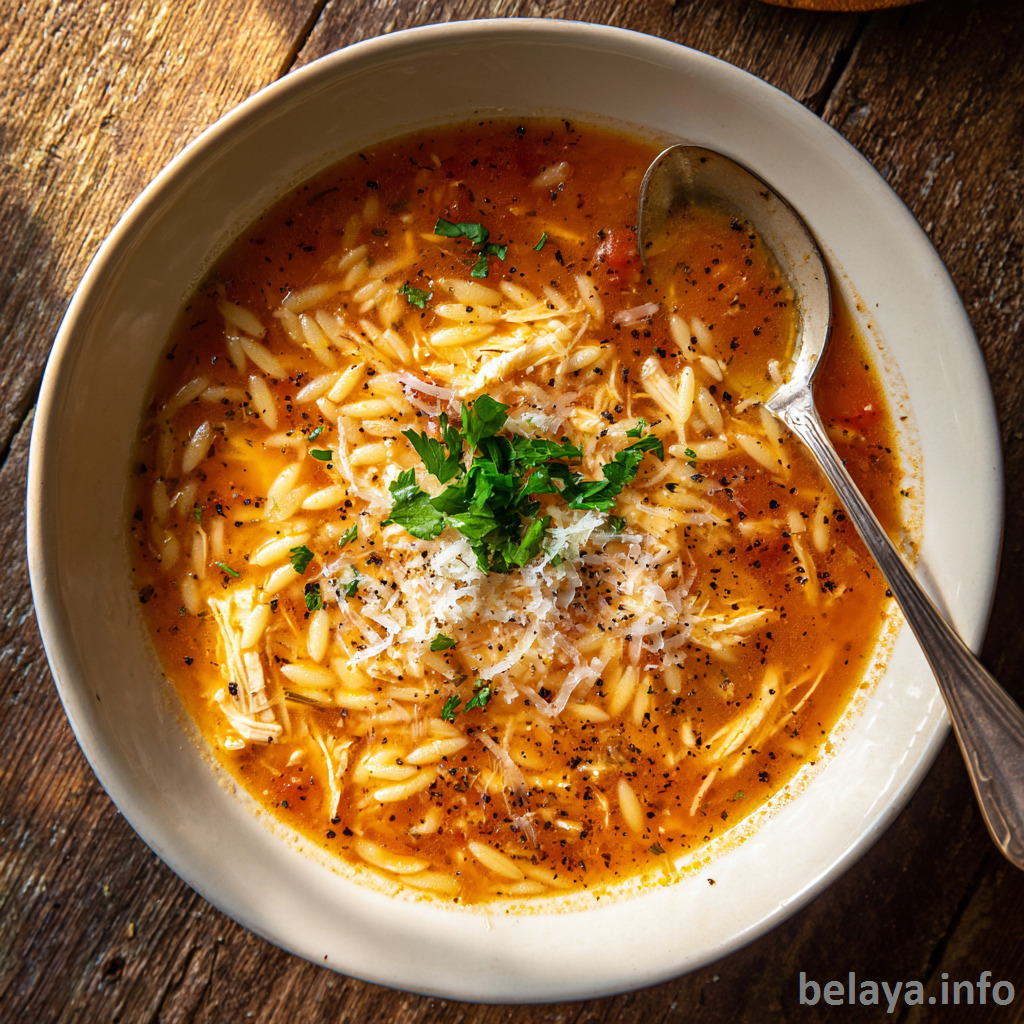
Instructions:
Sauté the Base Aromatics:
In a large pot over medium heat, melt the butter. Add the finely chopped onion and cook for 3–4 minutes until translucent. Stir in the crushed garlic, thyme, and rosemary, and sauté for another minute until fragrant.
Build the Flavor:
Add the tomato paste, balsamic vinegar (if using), and Worcestershire sauce (if using). Stir well to combine and coat the aromatics in the paste.
Simmer the Broth:
Pour in the chicken or vegetable stock and bring the mixture to a gentle simmer. Let it cook for 10 minutes to deepen the flavor.
Cook the Pasta Separately:
While the soup simmers, cook the Rosa Marina (orzo) in a separate pot of generously salted boiling water according to package directions. Drain and set aside.
Add Cream and Seasonings:
Stir the heavy cream into the soup (if using). Season with salt and freshly ground pepper to taste.
Add Greens and Chicken:
Add the spinach to the pot and stir until just wilted. Then stir in the cooked, shredded chicken to warm through.
Finish with Brightness:
Remove the soup from the heat and stir in the fresh lemon juice for a vibrant, tangy finish.
Serve and Garnish:
Ladle the soup into bowls. Top with shaved Parmesan and a sprinkle of fresh basil or parsley. Serve warm.
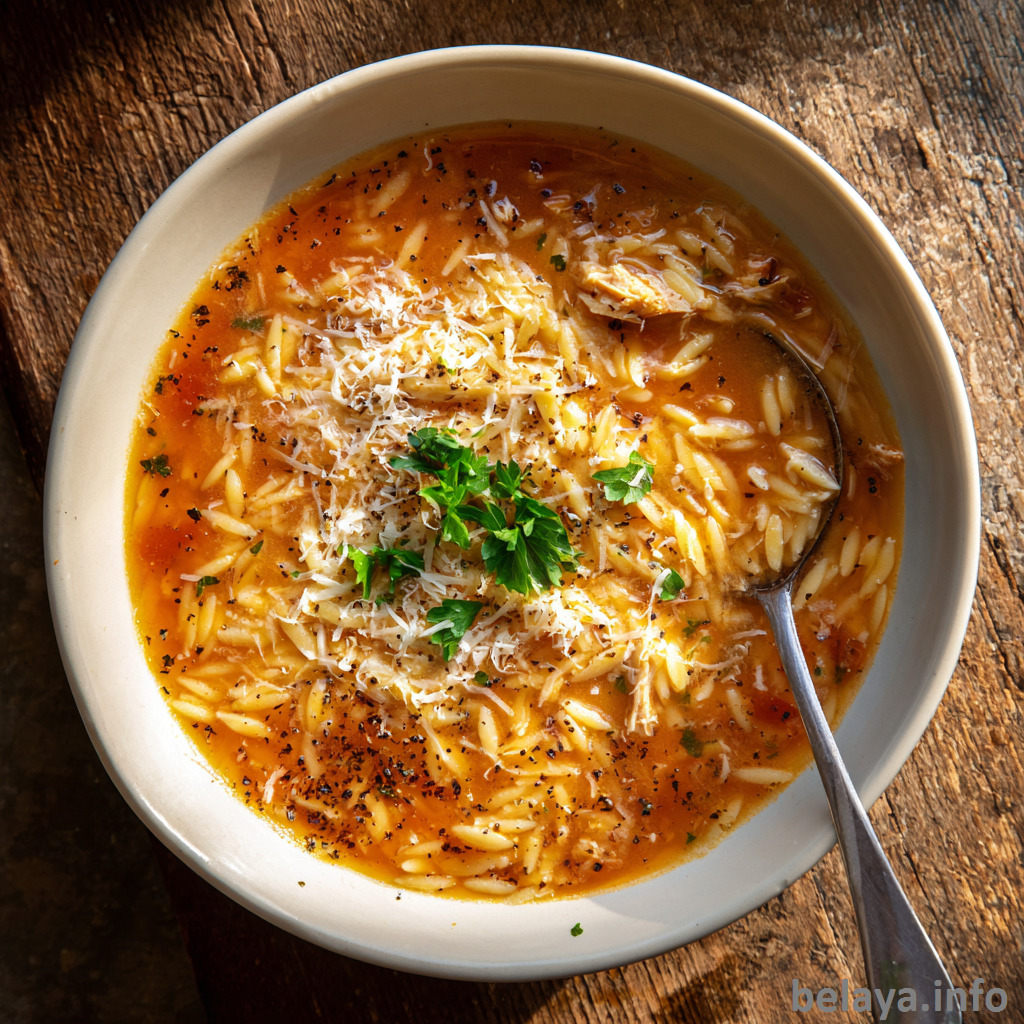
Important Notes When Making Rosa Mariana Soup:
Cook Orzo Separately to Avoid Cloudy Broth
Cooking the orzo (Rosa Marina pasta) in a separate pot prevents excess starch from thickening or clouding the broth. This keeps the soup’s texture clean and the broth light yet flavorful.
Simmer, Don’t Boil
Once the stock is added, avoid vigorous boiling. A gentle simmer allows flavors to develop slowly and prevents delicate ingredients like spinach or cream from breaking down or curdling.
Add Cream and Lemon at the End
Both heavy cream and lemon juice are best stirred in after removing the soup from the heat. Adding them while boiling can cause separation. This finishing technique also locks in brightness and silkiness without dulling their effect.
Use Fresh Herbs for Final Impact
While dried herbs work in the base, fresh parsley or basil as a garnish are essential for aroma and visual contrast. They add a final burst of freshness and elevate the soup’s presentation.
Balance Salt With Acidity
Tomato paste, stock, and cheese can all contain salt. Hold off on additional salting until after adding lemon juice, which can make the soup taste brighter and reduce the need for more salt.
Optional Ingredients Add Depth Without Complication
Ingredients like balsamic vinegar, Worcestershire sauce, and cream are optional—but when used thoughtfully, they create layered, restaurant-style complexity. Use sparingly and taste as you go.
Perfect for Make-Ahead – with One Adjustment
The flavors deepen beautifully over time, but orzo can swell and soften in leftover soup. To maintain ideal texture for meal prep, store pasta separately and combine just before serving.

How To Enjoy Rosa Mariana Soup After Cooking:
Let It Rest Before Serving
Once the soup is finished, remove it from heat and let it sit for 5–10 minutes, covered.
This short resting time allows the orzo to absorb flavor, the herbs to meld into the broth, and the temperature to settle for more comfortable eating.
Serve It with Intention
Ladle the soup into warm bowls to maintain temperature longer.
Top each bowl with freshly shaved Parmesan, a drizzle of olive oil, or a few drops of balsamic glaze for a restaurant-style finish.
Sprinkle with fresh basil or parsley to add brightness and contrast.
Pair It Perfectly
Serve alongside:
- Warm crusty Italian bread or garlic focaccia
- A light side salad (arugula with lemon vinaigrette pairs beautifully)
- Grilled cheese or bruschetta for a more filling option
Store Thoughtfully
Allow leftovers to cool to room temperature, then store in airtight containers in the fridge for up to 4 days.
For best texture, store the orzo separately from the broth, especially if you plan to reheat multiple times, to avoid sogginess.
Reheat Gently
Reheat the soup on the stovetop over medium-low heat, stirring occasionally until warmed through.
If using the microwave, cover loosely and reheat in short intervals, stirring between each one to heat evenly.
Add a splash of water or broth if the soup has thickened too much.
Refresh Before Serving Again
Stir in fresh lemon juice, herbs, or a touch of cream before serving leftovers to bring back brightness.
Reheat Parmesan separately or freshly grate it on top for best flavor and texture.
Transform Leftovers Creatively
Add extra greens (like kale or arugula) and reheat for a new twist.
Stir in leftover roasted vegetables or beans to bulk it up for a second-day lunch.
Use it as a sauce base: reduce the broth slightly and toss with grilled chicken and sautéed vegetables over pasta.
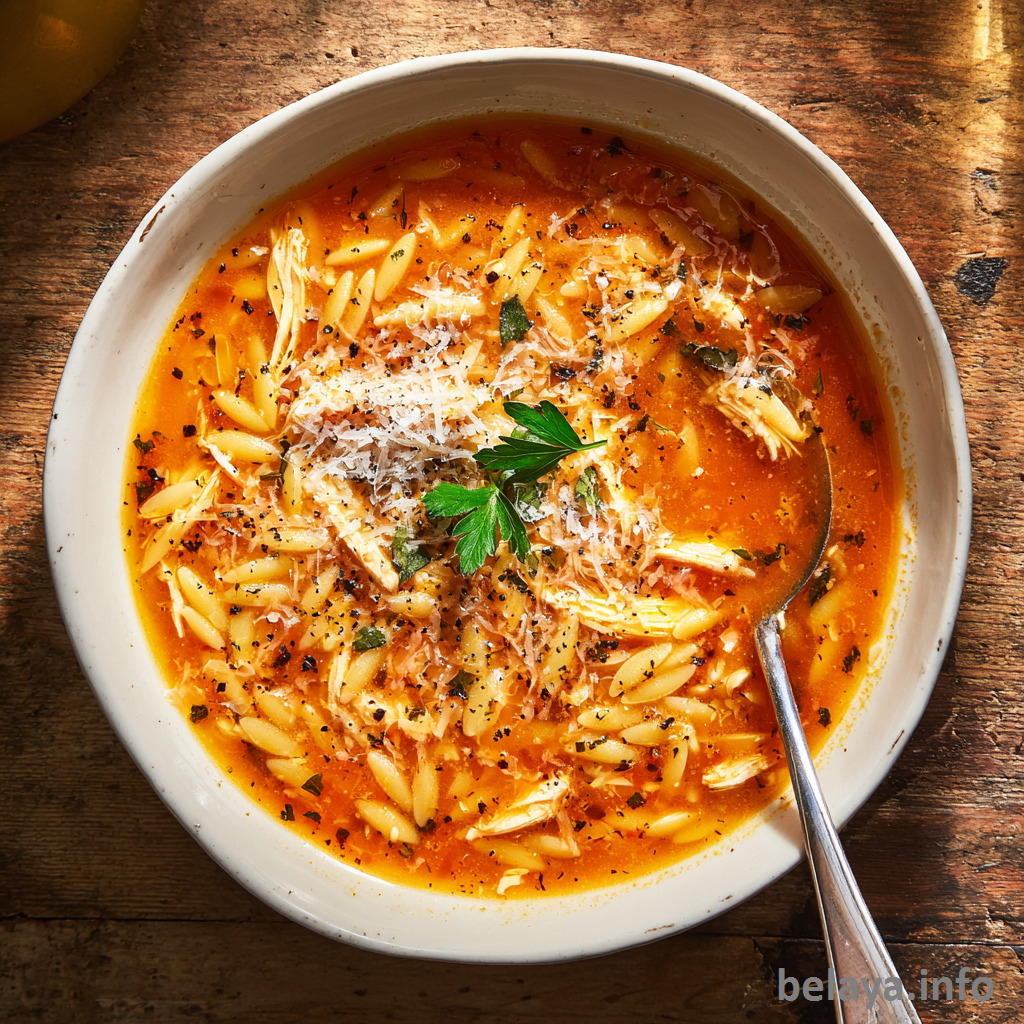
Nutrition Information:
For one serving of Rosa Mariana Soup (Italian Orzo Soup with Chicken and Tomato).
Assuming the recipe yields about 6 servings and includes optional ingredients like cream and chicken:
Calories: 280 kcal | Total Fat: 11.5 g | Saturated Fat: 5.2 g | Monounsaturated Fat: 3.8 g | Polyunsaturated Fat: 1.0 g | Cholesterol: 55 mg | Sodium: 520–650 mg (depending on stock and added salt) | Total Carbohydrates: 27.6 g | Dietary Fiber: 2.4 g | Sugars: 5.2 g | Protein: 19.4 g
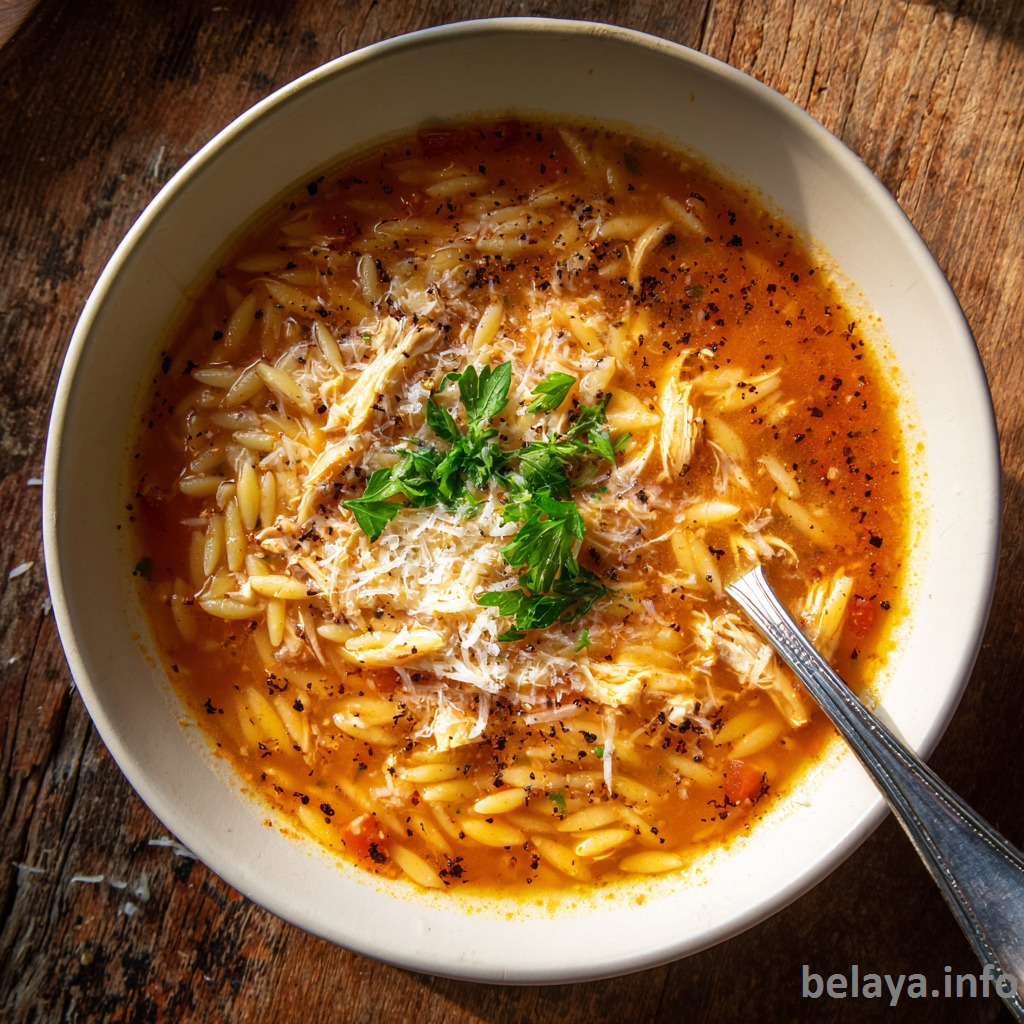
Frequently Asked Questions:
Can I substitute another pasta for Rosa Marina or orzo?
Yes. You can use small pasta shapes like acini di pepe, ditalini, or even broken angel hair as substitutes. Just be sure to adjust cooking time accordingly and cook separately to avoid over-softening the soup.
Do I have to use chicken in this recipe?
No. The soup is very flexible. You can leave out the chicken for a vegetarian version or replace it with white beans, tofu, or chickpeas for added protein while keeping it meat-free.
What’s the best way to avoid soggy orzo in leftovers?
Cook and store the pasta separately. Add the orzo to individual bowls when serving, then ladle the hot broth over it. This keeps the texture ideal even after refrigerating or freezing.
Can I make this soup ahead of time?
Absolutely. The broth and aromatics taste even better the next day. Just reheat gently and consider adding fresh herbs, lemon juice, or Parmesan to refresh the flavor before serving.
Do I need to include the cream, vinegar, and Worcestershire sauce?
Not necessarily. These ingredients are optional, but they add depth:
- Cream brings a silky richness,
- Balsamic vinegar adds a subtle tang, and
- Worcestershire sauce adds savory umami.
Even without them, the soup remains flavorful and balanced—perfect for lighter preferences.
Should I cook the orzo directly in the soup or separately?
Cook it separately. Cooking orzo in the soup can make the broth starchy and cause the pasta to overcook, especially in leftovers. Boiling it separately and adding it just before serving keeps the texture firm and the broth clean.
When should I add the cream and lemon juice?
After removing the soup from heat. Adding cream or lemon juice while the soup is still boiling can cause curdling. Stir them in gently at the end for a smooth, balanced finish.
Can I use dried herbs instead of fresh rosemary and thyme?
Yes. Use about 1/3 the amount if substituting dried herbs (e.g., ¾ tsp dried thyme = 2 tsp fresh). Add them early during sautéing to allow their flavors to bloom in the fat.
What if my soup tastes too acidic or too flat?
If it’s too acidic, add a pinch of sugar or stir in a bit more cream to mellow it out.
If it’s too flat, try adding a splash more lemon juice, a touch of Worcestershire sauce, or a sprinkle of salt to enhance the flavors.
Can I make this soup in one pot to save time?
You can, but with a trade-off. Cooking the orzo in the same pot is convenient but may result in a thicker, starchier broth and softer pasta over time. For best results, use one pot for the soup and a separate one for the orzo, then combine them when serving.